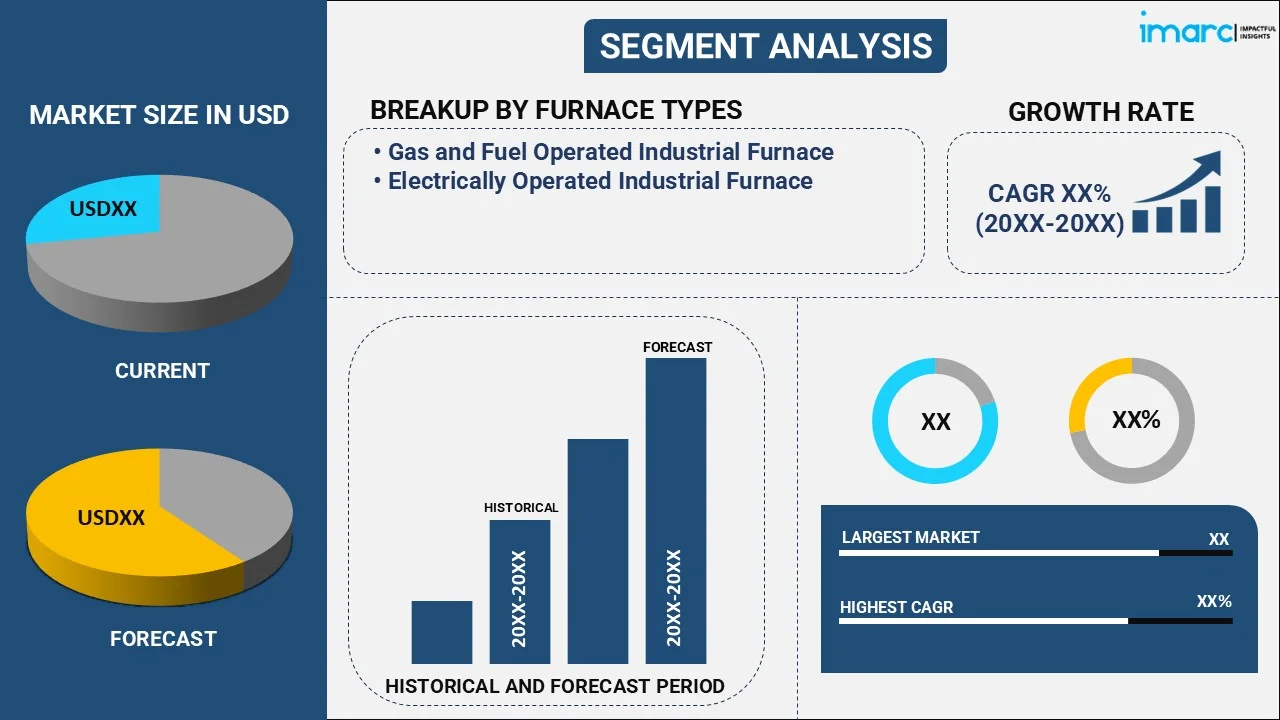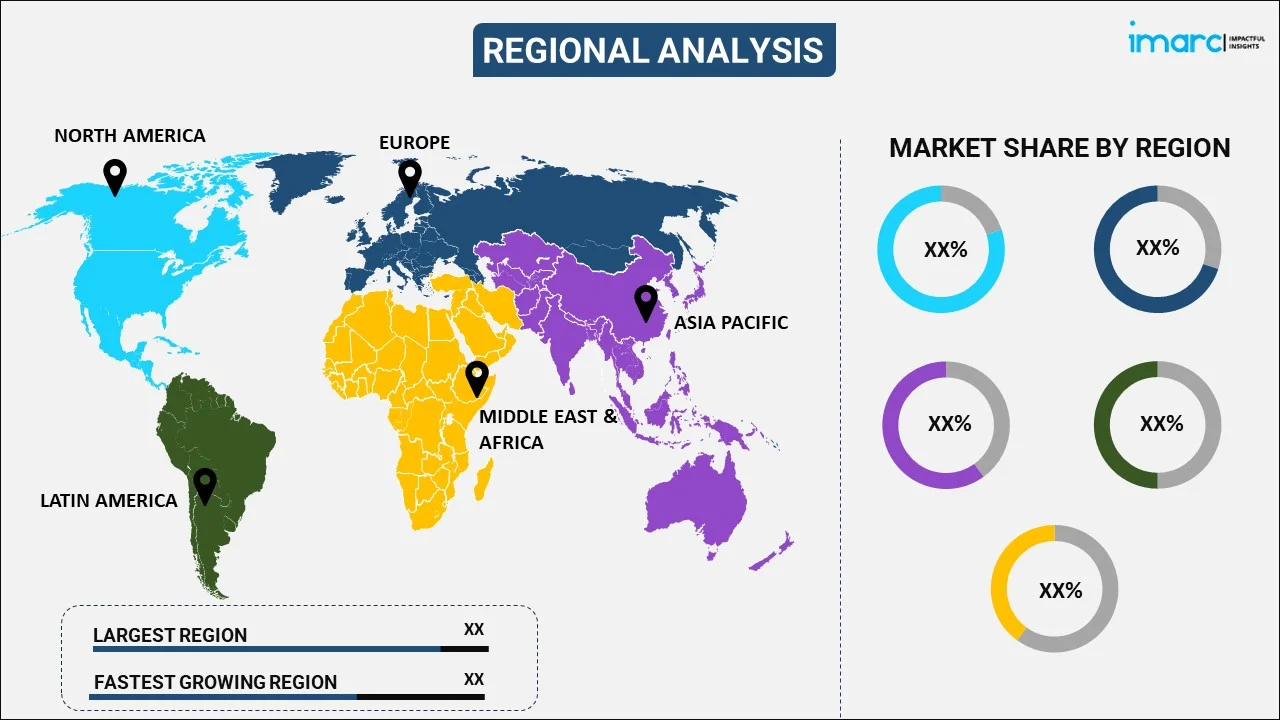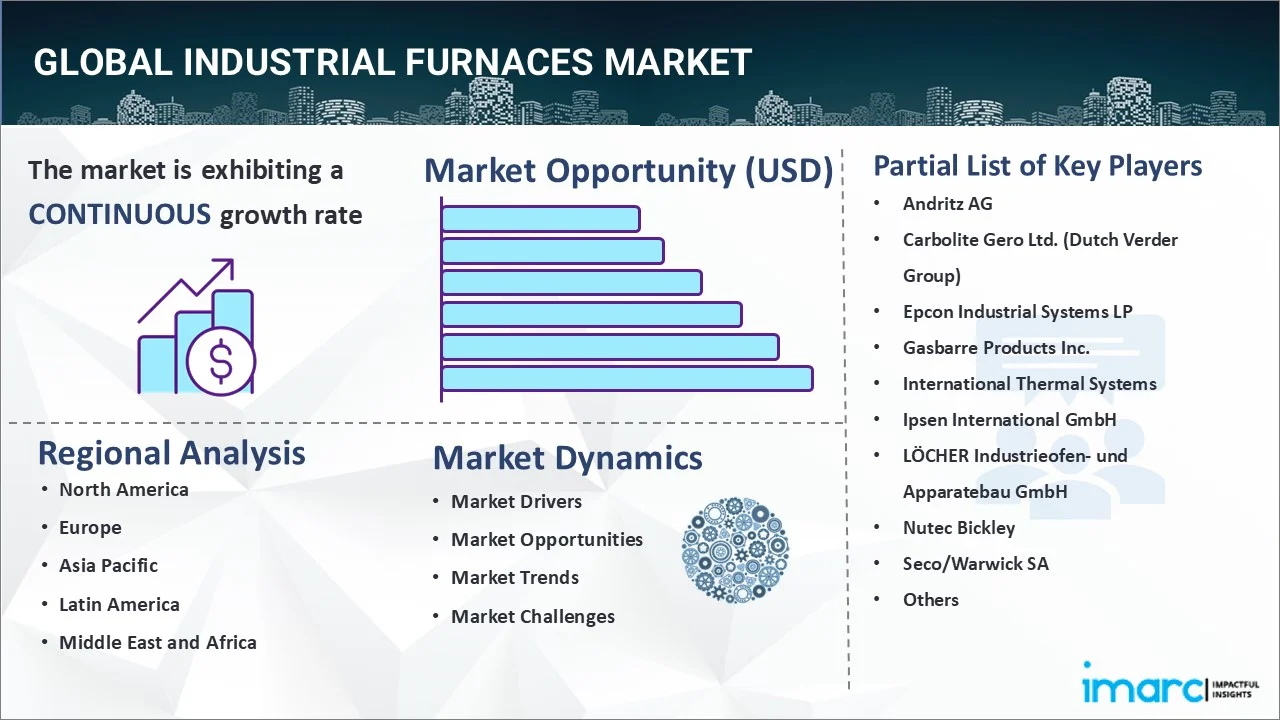
Industrial Furnaces Market Report by Furnace Type (Gas and Fuel Operated Industrial Furnace, Electrically Operated Industrial Furnace), Arrangement (Tube or Clamshell Type, Box Type, Bottom Loading and Car Bottom Furnace, Top Loading Furnace, and Others), End Use (Metals and Mining, Transportation, Oil and Gas, Chemicals, and Others), and Region 2025-2033
Industrial Furnaces Market Size:
The global industrial furnaces market size reached USD 14.4 Billion in 2024. Looking forward, IMARC Group expects the market to reach USD 21.7 Billion by 2033, exhibiting a growth rate (CAGR) of 4.4% during 2025-2033. The expansion of manufacturing sectors, rising demand for high-quality steel and aluminum, rapid technological advancements, regulatory pressures for energy efficiency, growth in aerospace and defense industries, and the shift toward sustainable practices are some of the factors boosting the market growth.
|
Report Attribute
|
Key Statistics
|
|---|---|
|
Base Year
|
2024
|
|
Forecast Years
|
2025-2033
|
|
Historical Years
|
2019-2024
|
|
Market Size in 2024
|
USD 14.4 Billion |
|
Market Forecast in 2033
|
USD 21.7 Billion |
| Market Growth Rate (2025-2033) | 4.4% |
Industrial Furnaces Market Analysis:
- Major Market Drivers: Industrial furnaces are witnessing huge demand across umpteen manufacturing processes due to the escalating need for energy-efficient heating solutions, which represents one of the primary factors bolstering the market growth. Additionally, the inclination towards automation and the development of Industry 4.0 are surging the demand for more sophisticated furnaces that deliver an accurate control of temperature along with efficient energy consumption, which is supporting the market growth. Furthermore, the increasing investments in metal and steel have burgeoned the industrial furnaces demand owing to the industry’s critical use of furnaces in a number of heat treatment processes. Moreover, the escalating use of sustainable manufacturing processes is promoting the demand for furnaces that operate on substitute fuels and minimize carbon emissions, which is another growth-inducing factor for the market.
- Key Market Trends: The advancements in digitalization and the integration of the Internet of Things (IoT) and artificial intelligence (AI) in industrial furnaces market are some of the factors facilitating the market growth. Digitization further helps in raising operational efficiency and reducing downtimes by enabling predictive maintenance. Moreover, the shift toward electric furnace as it significantly reduces carbon footprint than traditional fuel-based generating furnaces is another factor driving the industrial furnaces market share. Furthermore, the trend of tailoring furnaces to meet specific industry requirements and a growing tendency of revamping and modernizing existing furnace infrastructure to extend its lifespan is contributing to a positive industrial furnaces market outlook.
- Geographical Trends: Asia Pacific is the largest market of global industrial furnaces due to its robust manufacturing sector and burgeoning investment in industrial infrastructure. China holds the largest share in the regional market as the country is backed by a massive manufacturing base and high consumption of industrial goods. In North America and Europe, technology advancements and the availability of established players are providing a considerable thrust to the regions market growth. In these regions, the emphasis is on innovation and sustainable practices, leading to the development of advanced furnace technologies.
- Competitive Landscape: Some of the major market players in the industrial furances industry include Andritz AG, Carbolite Gero Ltd. (Dutch Verder Group), Epcon Industrial Systems LP, Gasbarre Products Inc., International Thermal Systems, Ipsen International GmbH, LÖCHER Industrieofen- und Apparatebau GmbH, Nutec Bickley, Seco/Warwick SA, Thermal Product Solutions and Thermcraft Incorporated, among many others.
- Challenges and Opportunities: The global industrial furnaces industry is restrained by several factors such as stringent environmental regulations and the high cost involved in the development of advanced furnaces. Compliance with these strict emission regulations have considerably surged the investments in cleaner technologies, which is further creating a barrier for the smaller companies. The volatility of raw material prices is another restraint as it considerably increased the production costs. However, these challenges present opportunities for innovation and growth. The development of cost-effective, energy-efficient furnaces that meet regulatory requirements is a significant opportunity for the industrial furnaces market growth.
Industrial Furnaces Market Trends:
Expansion of the Manufacturing Sector
The expansion of the manufacturing sector in the emerging regions represents one of the major drivers fueling the market growth. According to the industrial furnaces market forecast, in China, the manufacturing output was about USD 4,975.61 billion in 2022, which was an increase of about 1.36% from 2021. With the industrialization in countries such as China, India and Brazil, there is an increase in demand for high-capacity industrial furnaces to meet a variety of needs in the manufacturing process, which is further fostering the market growth. The industrial furnaces market value is also driven by the rapidly expanding automotive, construction, and infrastructure sectors and surging requirement for cost-effective and energy-efficient furnace technologies in these regions.
Increasing Demand for High-Quality Steel and Aluminum
Steel and aluminum are witnessing a considerable demand across industries, which is further boosting the market growth. For instance, in the US, steel demand witnessed a modest increase of about 1.6% in 2023. Steel and aluminum are largely used across various industries, including aerospace, construction, automotive, and consumer goods. In the automotive sector, the need for lighter, more fuel-efficient vehicles have surged the demand for robust steel and aluminum alloys, which has further spurred the demand for precise and high-performance furnace systems. Moreover, a strong focus on durable and high-strength materials in the construction sector has propelled demand for higher quality steel, which has further boosted the demand for industrial furnaces as they provide accurate temperature and chemical composition control to meet rigorous quality requirements.
Technological Advancements
The industrial furnaces market revenue is further bolstered by technological advancements, primarily in terms of efficiency, performance, and sustainability. Rapid industrialization and the incorporation of various technologies such as automation, IoT, and energy-saving systems in industrial furnaces are supporting the market growth. The automation helps in enabling accurate process control that helps increase efficiency in furnace operations, further reducing the need for manual intrusion. Moreover, IoT integration helps improve the operational efficiency and enable predictive analysis, which further increases operational efficiency and predictive maintenance capabilities. These technological advancements not only enhance the operational capabilities of industrial furnaces but also support the industry's shift towards more sustainable and efficient manufacturing processes.
Industrial Furnaces Market Segmentation:
IMARC Group provides an analysis of the key trends in each segment of the market, along with forecasts at the global, regional, and country levels for 2025-2033. Our report has categorized the market based on furnace type, arrangement, and end use.
Breakup by Furnace Type:

- Gas and Fuel Operated Industrial Furnace
- Electrically Operated Industrial Furnace
Gas and fuel operated industrial furnace accounts for the majority of the market share
The report has provided a detailed breakup and analysis of the market based on the furnace type. This includes gas and fuel operated industrial furnace and electrically operated industrial furnace. According to the report, gas and fuel operated industrial furnace represented the largest segment.
The gas and fuel-operated industrial furnace segment is driven by the increasing demand for energy efficiency and cost-effectiveness in industrial processes. As industries seek to optimize operational costs and reduce energy consumption, gas and fuel-operated furnaces offer significant advantages due to their high thermal efficiency and relatively lower operational costs compared to electric alternatives. Natural gas and fuel oil, commonly used in these systems, provide a cost-effective and stable energy source, making them attractive for high-volume production environments. Additionally, advancements in burner technology and combustion control have enhanced the efficiency of gas and fuel-operated furnaces, allowing for more precise temperature control and reduced fuel consumption.
Breakup by Arrangement:
- Tube or Clamshell Type
- Box Type
- Bottom Loading and Car Bottom Furnace
- Top Loading Furnace
- Others
Box type holds the largest share of the industry
A detailed breakup and analysis of the market based on the arrangement have also been provided in the report. This includes tube or clamshell type, box type, bottom loading and car bottom furnace, top loading furnace, and others. According to the report, box type accounted for the largest market share.
The box type segment is driven by the increasing demand for precise and uniform heating in various industrial processes. These furnaces are particularly valued for their ability to provide consistent temperature control and even heat distribution, which is essential for applications like annealing, tempering, and sintering. As industries such as automotive, aerospace, and electronics focus on producing high-quality components with stringent specifications, the need for reliable and efficient heating solutions becomes more pronounced. Box type furnaces offer versatility in accommodating various sizes and shapes of materials, making them suitable for diverse manufacturing needs. Additionally, the trend towards automation and smart manufacturing further supports the box type segment, as these furnaces can be integrated with advanced control systems and IoT technologies for enhanced monitoring and process optimization.
Breakup by End Use:
- Metals and Mining
- Transportation
- Oil and Gas
- Chemicals
- Others
Metals and mining dominates the market
The report has provided a detailed breakup and analysis of the market based on the end use. This includes metals and mining, transportation, oil and gas, chemicals, and others. According to the report, metals and mining represented the largest segment.
The metals and mining segment is driven by the increasing demand for raw materials and technological advancements in furnace technology. As industrialization accelerates globally, the need for metals such as steel, aluminum, copper, and rare earth elements rises significantly. These materials are fundamental in manufacturing infrastructure, automotive components, electronics, and various other products. The expansion of construction projects, particularly in developing countries, demands substantial quantities of steel and aluminum, propelling the need for efficient and high-capacity industrial furnaces. Moreover, technological innovations in furnace design, including the development of energy-efficient systems and advanced automation, play a crucial role in meeting this growing demand.
Breakup by Region:

- North America
- United States
- Canada
- Asia-Pacific
- China
- Japan
- India
- South Korea
- Australia
- Indonesia
- Others
- Europe
- Germany
- France
- United Kingdom
- Italy
- Spain
- Russia
- Others
- Latin America
- Brazil
- Mexico
- Others
- Middle East and Africa
Europe leads the market, accounting for the largest industrial furnaces market share
The industrial furnaces market report has also provided a comprehensive analysis of all the major regional markets, which include North America (the United States and Canada); Asia Pacific (China, Japan, India, South Korea, Australia, Indonesia, and others); Europe (Germany, France, the United Kingdom, Italy, Spain, Russia, and others); Latin America (Brazil, Mexico, and others); and the Middle East and Africa. According to the report, Europe represents the largest regional market for industrial furnaces.
The Europe regional market is driven by the increasing industrial production across various sectors, particularly in automotive, aerospace, and heavy machinery. As European nations continue to focus on advanced manufacturing processes and technological innovation, there is a rising demand for high-performance industrial furnaces. The automotive industry, a cornerstone of Europe's industrial base, requires sophisticated furnace systems for the production of high-quality metals and components that meet stringent safety and efficiency standards. In line with this, the aerospace sector's push for advanced materials and precision manufacturing drives the need for specialized furnace technologies capable of producing components with exacting specifications. Furthermore, heavy machinery and equipment manufacturing also contribute to the growth, as these sectors demand robust furnace systems for the production of durable and high-strength materials.
Competitive Landscape:
- The industrial furnaces market research report has also provided a comprehensive analysis of the competitive landscape in the market. Detailed profiles of all major companies have also been provided. Some of the major market players in the industrial furnaces industry include Andritz AG, Carbolite Gero Ltd. (Dutch Verder Group), Epcon Industrial Systems LP, Gasbarre Products Inc., International Thermal Systems, Ipsen International GmbH, LÖCHER Industrieofen- und Apparatebau GmbH, Nutec Bickley, Seco/Warwick SA, Thermal Product Solutions, Thermcraft Incorporated, etc.
(Please note that this is only a partial list of the key players, and the complete list is provided in the report.)
- A detailed market overview highlights the key players and their market strategies in the industrial furnaces sector. For instance, key players are focusing on innovation and technological advancements to stay competitive. They are investing heavily in research and development (R&D) to enhance furnace efficiency, reduce energy consumption, and improve environmental sustainability. They are also incorporating advanced technologies such as automation, IoT integration, and smart controls to offer more precise and reliable furnace systems. Additionally, there is a strong emphasis on developing eco-friendly solutions that comply with stringent environmental regulations, including low-emission designs and heat recovery systems. Strategic partnerships and collaborations with other technology providers are also common, aiming to integrate complementary technologies and broaden product offerings.
Industrial Furnaces Market News:
- In 2023, Kyocera Launched a New Standard Line of 230V Silicon Nitride (SN) Igniters for Industrial and Residential Gas Furnaces, Boilers, and Gas Stoves.
- In 2023, Ipsen International GmbH shipped a Turbo²Treater® vacuum furnace to Tratamientos Termicos Avanzados (TTA) in Monterrey, Mexico. This advanced furnace features a work zone of 24” x 24” x 36”, a weight capacity of 1,600 pounds, a maximum operating temperature of 2,400°F, and quench pressure up to 12 bar. It will primarily be used for hardening tool steels but offers flexibility for other processes.
Industrial Furnaces Market Report Scope:
| Report Features | Details |
|---|---|
| Base Year of the Analysis | 2024 |
| Historical Period | 2019-2024 |
| Forecast Period | 2025-2033 |
| Units | Billion USD |
| Scope of the Report | Exploration of Historical Trends and Market Outlook, Industry Catalysts and Challenges, Segment-Wise Historical and Future Market Assessment:
|
| Furnace Types Covered | Gas and Fuel Operated Industrial Furnace, Electrically Operated Industrial Furnace |
| Arrangements Covered | Tube or Clamshell Type, Box Type, Bottom Loading and Car Bottom Furnace, Top Loading Furnace, Others |
| End Uses Covered | Metals and Mining, Transportation, Oil and Gas, Chemicals, Others |
| Regions Covered | Asia Pacific, Europe, North America, Latin America, Middle East and Africa |
| Countries Covered | United States, Canada, Germany, France, United Kingdom, Italy, Spain, Russia, China, Japan, India, South Korea, Australia, Indonesia, Brazil, Mexico |
| Companies Covered | Andritz AG, Carbolite Gero Ltd. (Dutch Verder Group), Epcon Industrial Systems LP, Gasbarre Products Inc., International Thermal Systems, Ipsen International GmbH, LÖCHER Industrieofen- und Apparatebau GmbH, Nutec Bickley, Seco/Warwick SA, Thermal Product Solutions, Thermcraft Incorporated, etc. |
| Customization Scope | 10% Free Customization |
| Post-Sale Analyst Support | 10-12 Weeks |
| Delivery Format | PDF and Excel through Email (We can also provide the editable version of the report in PPT/Word format on special request) |
Key Benefits for Stakeholders:
- IMARC’s industry report offers a comprehensive quantitative analysis of various market segments, historical and current market trends, market forecasts, and dynamics of the industrial furnaces market from 2019-2033.
- The research report provides the latest information on the market drivers, challenges, and opportunities in the global industrial furnaces market.
- The study maps the leading, as well as the fastest-growing, regional markets. It further enables stakeholders to identify the key country-level markets within each region.
- Porter's five forces analysis assists stakeholders in assessing the impact of new entrants, competitive rivalry, supplier power, buyer power, and the threat of substitution. It helps stakeholders to analyze the level of competition within the industrial furnaces industry and its attractiveness.
- The competitive landscape allows stakeholders to understand their competitive environment and provides insight into the current positions of key players in the market.
Key Questions Answered in This Report
The global industrial furnaces market was valued at USD 14.4 Billion in 2024.
We expect the global industrial furnaces market to exhibit a CAGR of 4.4% during 2025-2033.
The sudden outbreak of the COVID-19 pandemic had led to the implementation of stringent lockdown regulations across several nations, resulting in the temporary closure of numerous end-use industries for industrial furnaces.
The rising demand for industrial furnaces for manufacturing and heat-treating of metallic automotive parts is primarily driving the global industrial furnaces market.
Based on the furnace type, the global industrial furnaces market can be categorized into gas and fuel operated industrial furnace and electrically operated industrial furnace. Currently, gas and fuel operated industrial furnace accounts for the majority of the total market share.
Based on the arrangement, the global industrial furnaces market has been segregated into tube or clamshell type, box type, bottom loading and car bottom furnace, top loading furnace, and others. Among these, box type currently holds the largest market share.
Based on the end use, the global industrial furnaces market can be bifurcated into metals and mining, transportation, oil and gas, chemicals, and others. Currently, the metals and mining industry exhibits a clear dominance in the market.
On a regional level, the market has been classified into North America, Asia-Pacific, Europe, Latin America, and Middle East and Africa, where Europe currently dominates the global market.
Some of the major players in the global industrial furnaces market include Andritz AG, Carbolite Gero Ltd. (Dutch Verder Group), Epcon Industrial Systems LP, Gasbarre Products Inc., International Thermal Systems, Ipsen International GmbH, LÖCHER Industrieofen- und Apparatebau GmbH, Nutec Bickley, Seco/Warwick SA, Thermal Product Solutions, and Thermcraft Incorporated.
Need more help?
- Speak to our experienced analysts for insights on the current market scenarios.
- Include additional segments and countries to customize the report as per your requirement.
- Gain an unparalleled competitive advantage in your domain by understanding how to utilize the report and positively impacting your operations and revenue.
- For further assistance, please connect with our analysts.

 Inquire Before Buying
Inquire Before Buying
 Speak to an Analyst
Speak to an Analyst
 Request Brochure
Request Brochure
 Request Customization
Request Customization




.webp)




.webp)












